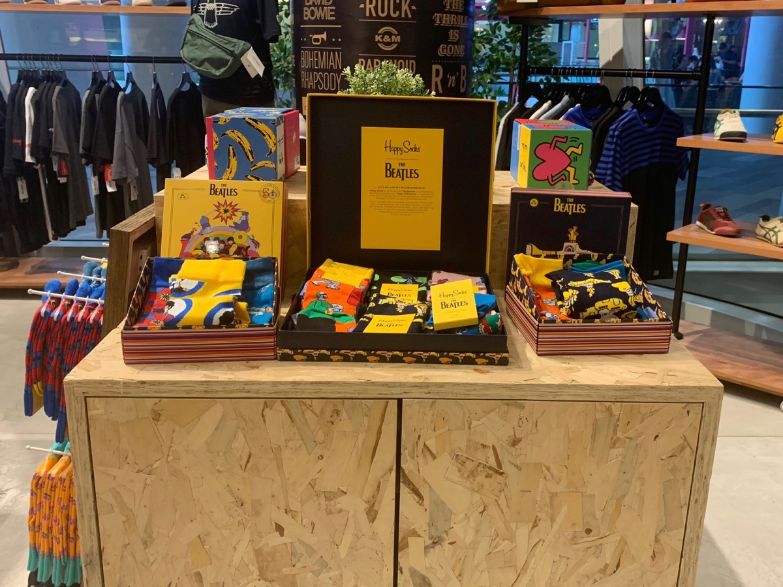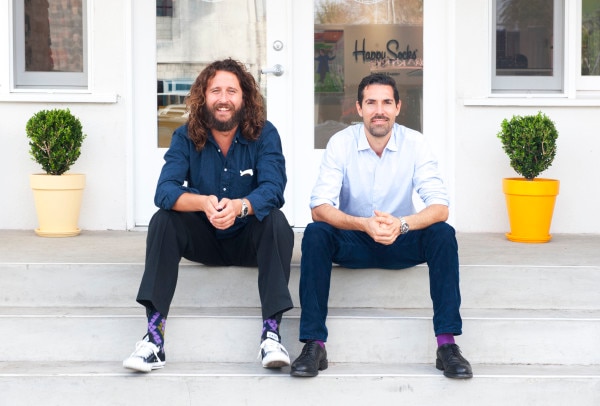Happy Socks have been making a boring wardrobe staple fun for 10 years now, reaching a whopping 12,000 stockists in over 90 countries. So, how did the fun-loving founders Mikael Söderlindh and Viktor Tell, who had no experience in eCommerce prior to launching the sock brand, create a $100 million dollar business?

How Happy Socks created a $100 million eCommerce business
Not all growth is created equal.
That’s why we created Masters of Commerce.
Receive expertly curated tips, news and insights to grow your business, direct to your inbox.
A pair of socks and a pair of friends
Happy Socks is all about bringing joy to an under-loved, overlooked garment- which it does through bright colors and bold sock patterns. In the words of Swedish founders Mikael Söderlindh and Viktor Tell, it’s simply about “doing what we like and having fun.” After finding out that people buy an average of 12-14 pairs of socks per year, they saw a huge opportunity in the market to make these purchases less mundane and more exciting.

Image courtesy: WGSN
With a “jump right in” attitude, the duo wasted no time launching their happy enterprise. Starting their endeavour in 2008, with no experience in socks or eCommerce , they optimistically aspired to be the first designer sock wholesale brand. Shortly after having this vision, they started the company, secured a factory in Turkey and began designing their first products. Flash forward 10 years later, Happy Socks have achieved an astounding amount of success, selling directly online and via third parties–both big department stores and global online retailers.
Stubbed toes on the path to happiness
That’s not to say that Happy Socks has been smooth sailing from the beginning. It took the company nearly six years to master eCommerce , and took a global team of experts to get the formula right, as they couldn’t rely on people just finding their brand in Happy Socks retailers’ stores. This was particularly true when organic traffic wasn’t as high as expected – people weren’t necessarily ready to order socks online, but rather preferred to find them in physical stores.

Image courtesy: WGSN
“Maybe not all the decisions have been the greatest ones because we wanted fun,” says Mikael Söderlindh. He reflects, “It’s so easy to say now that everything happened, everything’s so great, but no. It was tough. It’s been super tough to do it.”
Putting the best foot forward with local partnerships
The solution to the eCommerce problem was hiring the right people in-house and finding a global team who could localize web pages, work with warehouses, and market the business to bolster the organic traffic. Instead of starting with big, brand-name chains, they used local partners and successfully tapped into the entrepreneurial ecosystem in each of the 90 countries they work in. Building this local trust and brand recognition worked better than their wildest dreams - in fact, it’s a strategy they are still using today.
The brand’s presence has also been boosted with high-profile collaborations with names as diverse as Iris Apfel, The Beatles, and Snoop Dogg. All of this together has made the company a game changer in the sock world: “Everybody who didn’t do colorful socks, they do colorful socks today,” says Söderlindh.

With the brand recently expanding into underwear and a specific women’s sub-label (Hysteria), there’s something to be noted about having a strong brand image, furthermore one that universally uplifts people. As a result, the brand is the driving force behind their happy, loyal customers: “Our brand is stronger than just the product. So we could do a hotel or a spaceship. I don’t even know all we’re going to do,” says Tell.
Happy Socks is now moving to open branded store locations globally, including a Happy Socks NYC store, with the target for this year to reach 80-90 Happy Socks stores. Given the nature of the product, these stores would only need a small retail footprint of 500 square feet.
Key takeaways to knock your customers’ socks off
So what can other eCommerce retailers learn from Happy Socks? Here are a few takeaways:
- Take a global approach and find strong local partnerships with personal connections
- Hire the right people to build a global brand and strong eCommerce presence
- Focus on creating a brand that consumers love so that any changes to the product don’t matter









